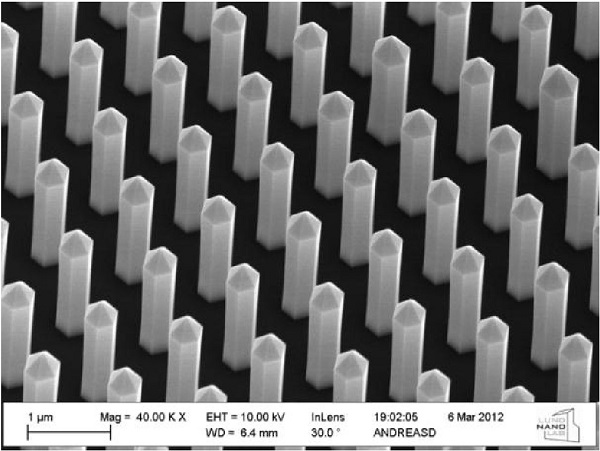Researchers from the Niels Bohr Institute have published a study that outlines how to improve the efficiency and brightness of light emitting diodes.
Specifically, the group studied LEDs made from nanowires. For those unfamiliar, nanowires are very small — just 2 micrometers high and about 10-500 nanometers in diameter. The ones used in LEDs feature an inner core made of gallium nitride and a layer of indium-gallium-nitride on the outside; that is, both layers feature semiconducting materials.  This image shows a series of the above-mentioned nanowires
This image shows a series of the above-mentioned nanowires
“The light in such a diode is dependent on the mechanical strain that exists between the two materials and the strain is very dependent on how the two layers are in contact with each other,” explains Robert Feidenhans'l, professor and head of the Niels Bohr Institute at the University of Copenhagen. “We have examined a number of nanowires using X-ray microscopy and even though the nanowires should in principle be identical, we can see that they are different and have very different structure.”
Using the aforementioned nanoscale X-ray microscopy in the electron synchrotron at DESY (Hamburg, Germany), the group measured a series of upright nanowires collectively using a special design of a nanofocused X-ray, and they were able to do this without destroying the nanowires in the process.
“We measured 20 nanowires and when we saw the images, we were very surprised because you could clearly see the details of each nanowire,” says Tomas Stankevic, a PhD student in the research group 'Neutron and X-ray Scattering' at the Niels Bohr Institute at the University of Copenhagen. “You can see the structure of both the inner core and the outer layer. If there are defects in the structure or if they are slightly bent, they do not function as well. So we can identify exactly which nanowires are the best and have the most efficient core/shell structure.”
Professor Feidenhans'l adds that there is great potential in these nanowires, as they’ll not only provide a more natural light in LEDs, but use much less power too. They could also one day be used in smart phones, televisions, and several other forms of lighting technology.
The group hopes things will continue to progress as fast as they’ve developed thus far; if that’s the case, they anticipate the technology being ready for use in five years.
Read the study: Fast Strain Mapping of Nanowire Light-Emitting Diodes Using Nanofocused X-ray Beams, which was published in the scientific journal, ACS Nano.
Via the University of Copenhagen
Advertisement
Learn more about Electronic Products Magazine





